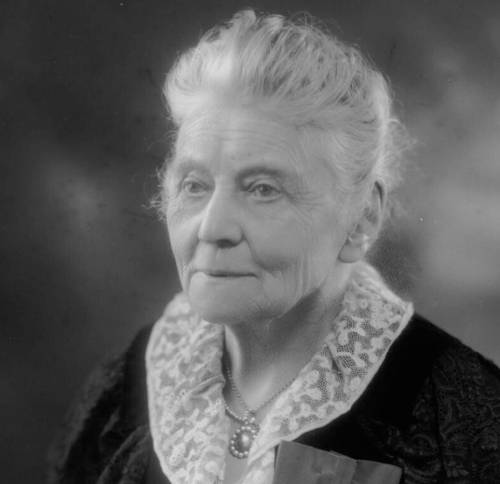DAME LOUISA LUMDSEN (1840-1935)

Dame Louisa Lumsden was a pioneer in female education, suffragist and anti-vivisection campaigner. Louisa Innes Lumsden was born in Aberdeen in 1840, the third daughter and youngest child of advocate Clements Lumsden and his wife Jane, née Forbes. The family was very well connected in Aberdeenshire. In her autobiography, Louisa remembered that in her childhood, The winters were spent in Aberdeen, but in summer we always went into the country, now to one place and again to another, as, unlike his brothers, my father had no settled country house. Uncle Hugh, Sheriff of Sutherland, lived at Pitcaple, Uncle Henry at Clova, Uncle Tom (Colonel HEICS) at Belhelvie and Uncle William at Balmedie.[1]
Having been educated at private schools in London and Brussels, in 1868-9 Louisa attended classes organised by the Edinburgh Ladies Education Association, which included lectures from University of Edinburgh professors. She then moved to Hitchin and became one of the first five students at a college founded by Emily Davies with the aim of educating women for the Cambridge Tripos examinations on equal terms with men. This college became Girton College when it moved to Cambridge in 1873 and Louisa was one of the first three women to sit unofficial University of Cambridge exams at this time. She then stayed on at Girton as a tutor.
In 1876-77 Louisa taught classics at Cheltenham Ladies College. In her autobiography she remembered:
The girls were delightful and keenly interested; in fact, so popular did Latin become, especially Virgil, that I had to ask Miss Beale to let me have an assistant, whereupon my friend, Constance Maynard, who had taken a First in the Moral Science Tripos, came to help me.
Both women then moved to St Andrews, where Louisa became the first headmistress of the newly founded St Leonards, the first school for young women in Scotland modelled on an English public school. Louisa and Constance worked together with another Girton graduate, Frances Dove in their establishment of the school. While Louisa only refers to Maynard and Dove as her close friends in her autobiography, much more becomes evident about the relationships between the three women from Maynard’s unpublished autobiography and diaries. During the late 1870s, Maynard, Dove and Lumsden formed a triangular relationship with Louisa referring to Constances as her wife; ‘I have been thinking over everything, and I am only too happy; my work, my home, my wife, all are good and I am satisfied’. In an article in Women’s History Review, Elizabeth Edwards points out that such relationships needed to be discreetly conducted, especially between the principals of a girls’ school, since they could not afford to endanger either their professional authority or their public respect by any hint of a scandal.
From 1896 to 1900 Louisa was the first warden of a new residential hall for women students at St Andrews University and in 1911 was awarded an honorary doctorate of laws by the university as part of its quincentenary celebrations. The all-female Lumsden club at the University of St Andrews is named in her honour.
On her retirement to Old Aberdeen in 1908 Louisa was asked by the Aberdeen Association for Women’s Suffrage (the constitutional suffragists) to become its President. As President of the Association she often wrote letters to Aberdeen newspapers, mainly responding to accusations of inactivity by members of the militant suffragette organisation the Women’s Social and Political Union (WSPU). In her autobiography, Yellow Leaves, Louisa comments:
The militant movement never came so far as Aberdeen. The only suffragette I ever heard, Christabel Pankhurst, did not impress me in the least. She came to Aberdeen, scolded us and bored me.
Actually, the militant movement came to Aberdeen quite frequently, with visits from both Mrs Pankhurst and Christabel and the establishment of a branch of the WSPU by 1907. In December 1909 Louisa had to write to the Free Press in response to a letter from ‘Suffra Jet’ in order to defend the Aberdeen Association for Women Suffrage from charges of indifferent members and few and lifeless meetings. Lumsden replied that while such charges might be true, it was not the fault of the committee, who were endeavouring to attract new and younger members, ‘except, of course, from militants, whom their rules exclude’. Yellow Leaves was published in 1933. It may be that Louisa’s claim that the militant movement did not come to Aberdeen is an example of time blurring memories, or perhaps she simply not wish to acknowledge the strength of the WSPU movement in Aberdeen in comparison to that of her own association. Nonetheless, Lumsden was considered to be a clear advocate of equality for women. When women achieved a limited franchise in 1918, some of the Scottish suffrage organisations organised the planting of an oak tree in Kelvingrove Park, Glasgow, in commemoration of the occasion. The 78 year-old Lumsden was given the honour of planting the tree.
Louisa Innes Lumsden was also a vehement anti-vivisectionist.[2] She refers to her interest in this issue in her autobiography:
I became a member of ‘The Scottish Society for the Prevention of Vivisection’, founded and so named by Miss Ivory of Edinburgh; and with her I went to Nairn and Elgin…. The Secretary of this new society, Mrs Fyvie Mayo, one of my neighbours in Old Aberdeen, and her friend Dr Ferdinands, were zealous workers, and among us we started a magazine, Our Fellow Mortals, of which Mrs Fyvie Mayo was editor until her death, when I took it up and carried it on for eleven years, when overwork compelled me to give it up, to the regret of its many readers.
The connection between the fight for woman suffrage and an interest in anti-vivisection was made explicit by Louisa Lumsden when she referred in her autobiography to animal welfare being ‘another and harder fight’ than that of woman suffrage. This linking of the fight for woman suffrage and the anti-vivisection campaign was not an unusual one. Many women who fought for equality of opportunity for their own sex were also drawn into the campaign for better treatment of animals.
Louisa Innes Lumsden was created a Dame in 1925. A memorial plaque to Louisa can be found at 214 Union Street, Aberdeen.
Entry writen by Sarah Pedersen
Further reading
Edwards, Elizabeth, ‘Homoerotic Friendship and College Principals, 1880-1960’. Women’s History Review, 4:2, 1995, pp. 149–163
Lumsden, Louisa Innes, Yellow Leaves, Memories of a Long Life. Edinburgh and London: William Blackwood and Sons, 1933
[1] Lumsden, Louisa Innes, Yellow Leaves, p. 5.
[2] See ‘Letters to the Editor’, Aberdeen Daily Journal, 31 May 1911, 3 June 1911, 6 June 1911, 14 June 1911, 15 June 1911, 21 June 1911.
Having been educated at private schools in London and Brussels, in 1868-9 Louisa attended classes organised by the Edinburgh Ladies Education Association, which included lectures from University of Edinburgh professors. She then moved to Hitchin and became one of the first five students at a college founded by Emily Davies with the aim of educating women for the Cambridge Tripos examinations on equal terms with men. This college became Girton College when it moved to Cambridge in 1873 and Louisa was one of the first three women to sit unofficial University of Cambridge exams at this time. She then stayed on at Girton as a tutor.
In 1876-77 Louisa taught classics at Cheltenham Ladies College. In her autobiography she remembered:
The girls were delightful and keenly interested; in fact, so popular did Latin become, especially Virgil, that I had to ask Miss Beale to let me have an assistant, whereupon my friend, Constance Maynard, who had taken a First in the Moral Science Tripos, came to help me.
Both women then moved to St Andrews, where Louisa became the first headmistress of the newly founded St Leonards, the first school for young women in Scotland modelled on an English public school. Louisa and Constance worked together with another Girton graduate, Frances Dove in their establishment of the school. While Louisa only refers to Maynard and Dove as her close friends in her autobiography, much more becomes evident about the relationships between the three women from Maynard’s unpublished autobiography and diaries. During the late 1870s, Maynard, Dove and Lumsden formed a triangular relationship with Louisa referring to Constances as her wife; ‘I have been thinking over everything, and I am only too happy; my work, my home, my wife, all are good and I am satisfied’. In an article in Women’s History Review, Elizabeth Edwards points out that such relationships needed to be discreetly conducted, especially between the principals of a girls’ school, since they could not afford to endanger either their professional authority or their public respect by any hint of a scandal.
From 1896 to 1900 Louisa was the first warden of a new residential hall for women students at St Andrews University and in 1911 was awarded an honorary doctorate of laws by the university as part of its quincentenary celebrations. The all-female Lumsden club at the University of St Andrews is named in her honour.
On her retirement to Old Aberdeen in 1908 Louisa was asked by the Aberdeen Association for Women’s Suffrage (the constitutional suffragists) to become its President. As President of the Association she often wrote letters to Aberdeen newspapers, mainly responding to accusations of inactivity by members of the militant suffragette organisation the Women’s Social and Political Union (WSPU). In her autobiography, Yellow Leaves, Louisa comments:
The militant movement never came so far as Aberdeen. The only suffragette I ever heard, Christabel Pankhurst, did not impress me in the least. She came to Aberdeen, scolded us and bored me.
Actually, the militant movement came to Aberdeen quite frequently, with visits from both Mrs Pankhurst and Christabel and the establishment of a branch of the WSPU by 1907. In December 1909 Louisa had to write to the Free Press in response to a letter from ‘Suffra Jet’ in order to defend the Aberdeen Association for Women Suffrage from charges of indifferent members and few and lifeless meetings. Lumsden replied that while such charges might be true, it was not the fault of the committee, who were endeavouring to attract new and younger members, ‘except, of course, from militants, whom their rules exclude’. Yellow Leaves was published in 1933. It may be that Louisa’s claim that the militant movement did not come to Aberdeen is an example of time blurring memories, or perhaps she simply not wish to acknowledge the strength of the WSPU movement in Aberdeen in comparison to that of her own association. Nonetheless, Lumsden was considered to be a clear advocate of equality for women. When women achieved a limited franchise in 1918, some of the Scottish suffrage organisations organised the planting of an oak tree in Kelvingrove Park, Glasgow, in commemoration of the occasion. The 78 year-old Lumsden was given the honour of planting the tree.
Louisa Innes Lumsden was also a vehement anti-vivisectionist.[2] She refers to her interest in this issue in her autobiography:
I became a member of ‘The Scottish Society for the Prevention of Vivisection’, founded and so named by Miss Ivory of Edinburgh; and with her I went to Nairn and Elgin…. The Secretary of this new society, Mrs Fyvie Mayo, one of my neighbours in Old Aberdeen, and her friend Dr Ferdinands, were zealous workers, and among us we started a magazine, Our Fellow Mortals, of which Mrs Fyvie Mayo was editor until her death, when I took it up and carried it on for eleven years, when overwork compelled me to give it up, to the regret of its many readers.
The connection between the fight for woman suffrage and an interest in anti-vivisection was made explicit by Louisa Lumsden when she referred in her autobiography to animal welfare being ‘another and harder fight’ than that of woman suffrage. This linking of the fight for woman suffrage and the anti-vivisection campaign was not an unusual one. Many women who fought for equality of opportunity for their own sex were also drawn into the campaign for better treatment of animals.
Louisa Innes Lumsden was created a Dame in 1925. A memorial plaque to Louisa can be found at 214 Union Street, Aberdeen.
Entry writen by Sarah Pedersen
Further reading
Edwards, Elizabeth, ‘Homoerotic Friendship and College Principals, 1880-1960’. Women’s History Review, 4:2, 1995, pp. 149–163
Lumsden, Louisa Innes, Yellow Leaves, Memories of a Long Life. Edinburgh and London: William Blackwood and Sons, 1933
[1] Lumsden, Louisa Innes, Yellow Leaves, p. 5.
[2] See ‘Letters to the Editor’, Aberdeen Daily Journal, 31 May 1911, 3 June 1911, 6 June 1911, 14 June 1911, 15 June 1911, 21 June 1911.



